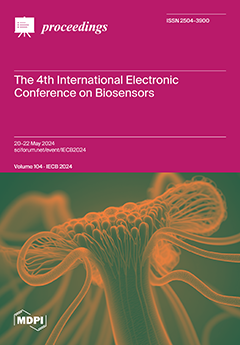Need Help?
Proceedings, 2024, IECB 2024
The 4th International Electronic Conference on Biosensors
Online | 20–22 May 2024
Volume Editors:
Giovanna Marrazza, University of Florence, Italy
Sara Tombelli, CNR-IFAC, Italy
- Issues are regarded as officially published after their release is announced to the table of contents alert mailing list.
- You may sign up for e-mail alerts to receive table of contents of newly released issues.
- PDF is the official format for papers published in both, html and pdf forms. To view the papers in pdf format, click on the "PDF Full-text" link, and use the free Adobe Reader to open them.
Cover Story (view full-size image):
With the success of the past three editions, the 4th International Electronic Conference on Biosensors (IECC 2024) was held on 20–22 May 2021 online. It was organized by the MDPI journal
[...] Read more.
With the success of the past three editions, the 4th International Electronic Conference on Biosensors (IECC 2024) was held on 20–22 May 2021 online. It was organized by the MDPI journal Biosensors and chaired by Professor Giovanna Marrazza and Dr. Sara Tombelli. Biosensors currently have an enormous range of applications due to their unique advantages, improving our overall quality of life with uses in, for example, environmental monitoring, disease detection, food safety, defense, drug discovery, and many others. This online conference aimed to gather important experts from around the world working in biosensors and provided an online forum for sharing and exchanging knowledge. Highly experienced researchers were invited to share their important advancements in the field.
Previous Issue
Next Issue
Issue View Metrics
Multiple requests from the same IP address are counted as one view.



